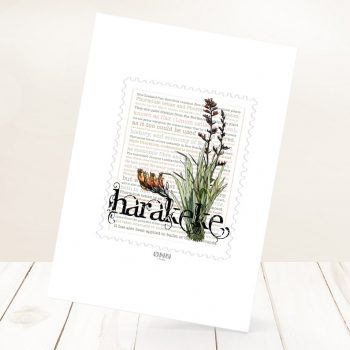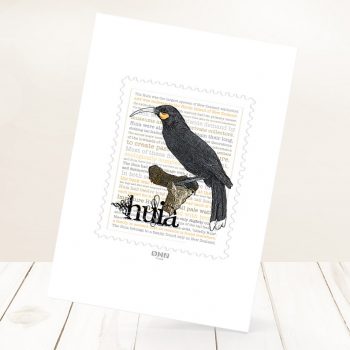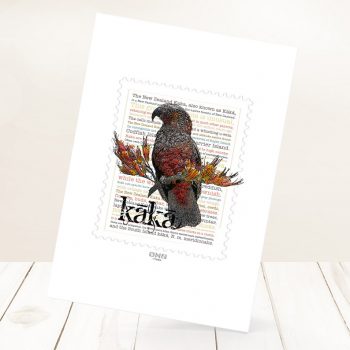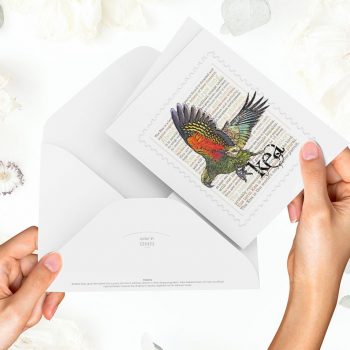TTONN product
-
Harakeke
$20.00 Add to cartPrint Size: 210mm x 297mm
Material: Card
New Zealand Flax, known by the Māori names Harakeke. Flax bushes will often support a large community of animals, providing shelter and an abundant food resource.
Although the Māori made textiles from a number of other plants, the use of harakeke and wharariki was predominant.
For centuries, Māori have used Harakeke for medicinal purposes, as a mild anaesthetic, poultice for boils, tumours, as well as to varicose ulcers. It also use as disinfectant and abscesses, relieve constipation, expel worms. The gum-like sap produced by Harakeke contains enzymes that give it blood clotting and antiseptic qualities to help healing processes.
-
Harakeke – card
$5.00 Add to cartHarakeke print on greeting blank card with a white envelope.
Size: 105mm x 148mm (A6)
Envelope size: 114mm x 162mm (C6) -
Huia
$20.00 Add to cartPrint Size: 210mm x 297mm
Material: Card
The Huia was the largest species of New Zealand wattlebird, endemic to the North Island of New Zealand. Its extinction in the early 20th century. The two major cause of extinction was overhunting to procure Huia skins for mounted specimens and the widespread deforestation of the lowlands of the North Island by European settlers. Huia were primarily found in broadleaf-podocarp forests where there was a dense understorey, with the lost of ancient, ecologically complex primary forests, they were unable to survive in regenerating secondary forests.
-
Kaka
$20.00 Add to cartPrint Size: 210mm x 297mm
Material: Card
The New Zealand Kaka, also known as Kākā, (Nestor meridionalis) is a New Zealand parrot endemic to the native forests of New Zealand.
The New Zealand Kaka lives in lowland and mid-altitude native forest. Its strongholds are currently the offshore reserves of Kapiti Island, Codfish Island and Little Barrier Island. It is breeding rapidly in the mainland island sanctuary at Zealandia (Karori Wildlife Sanctuary), with over 300 birds banded since their reintroduction in 2002.
-
Kākāpō (2017)
$20.00 Add to cartPrint Size: 210mm x 297mm
Material: Card
The Kākāpō, also called owl parrot, is a species of large, flightless nocturnal parrot endemic to New Zealand. Although it cannot fly, it is good at climbing trees. Kākāpō are the heaviest parrot in the world, and the only parrot to have a ‘lek’ mating system.
At the beginning of the 19th century, kākāpō were still widespread throughout New Zealand. From the 1840s, European settlers not only hunted the bird, but also set fire to bush for farming, destroying its habitat. By the 1970s, only a few isolated birds were known to exist in Fiordland, South Island. A survey of Stewart Island in 1977 found about 200 more birds but they were rapidly declining through predation by feral cats.
-
Kākāriki
$20.00 Add to cartPrint Size: 210mm x 297mm
Material: Card
The New Zealand parakeet. Its known by its Māori name of kākāriki, meaning ‘small green parrot’. There are five main species of kākāriki: Yellow-crowned parakeet, Orange-fronted parakeet, Red-crowned parakeet
Forbes’ parakeet and Antipodes Island parakeet.Mitochondrial DNA analysis has indicated that the orange-fronted parakeet is a separate species and not just a colour variation of the yellow-crowned parakeet. The orange-fronted parakeet is highly endangered, with less than 200 individuals remaining in the North Canterbury region of the South Island.
-
Kārearea
$20.00 Add to cartPrint Size: 210mm x 297mm
Material: Card
New Zealand falcon or Kārearea is endemic to this New Zealand and is one of our most spectacular birds. It capable of flying at speeds over 100 km/h, and can catch prey larger than itself.
Although still widespread where suitable habitat exists, numbers have declined and predation by cats, mustelids, and hedgehogs is emerging as a problem for ground nesting falcons.
-
Kauri – card
$5.00 Add to cartKauri print on greeting blank card with a white envelope.
Size: 105mm x 148mm (A6)
Envelope size: 114mm x 162mm (C6) -
Kea – card
$5.00 Add to cartKea print on greeting blank card with a white envelope.
Size: 105mm x 148mm (A6)
Envelope size: 114mm x 162mm (C6)









